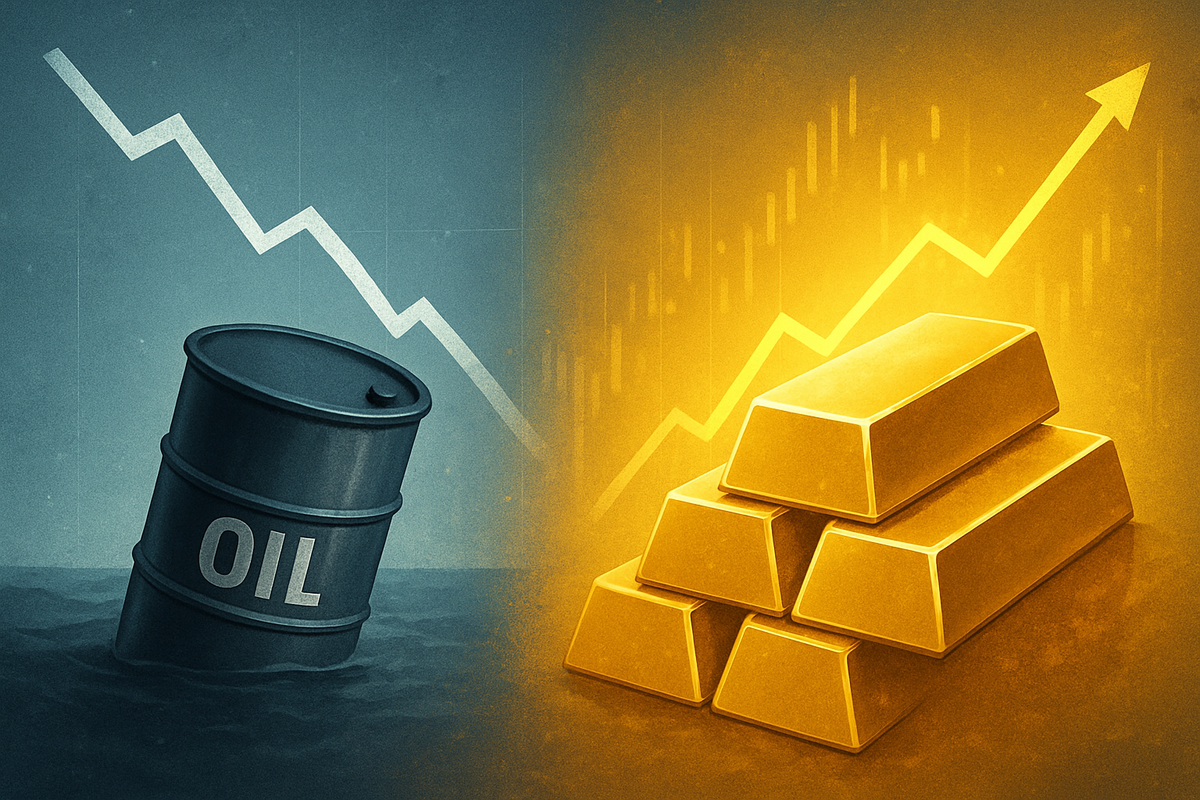
Global financial markets in November 2025 are navigating a complex landscape marked by a striking divergence in commodity prices: a significant decline in crude oil alongside an unprecedented surge in gold. This "golden paradox" is not merely a reflection of supply and demand dynamics but a potent indicator of pervasive economic uncertainty and shifting investor sentiment, with profound implications for various stock market sectors and the broader inflation outlook. While falling oil prices offer a glimmer of hope for moderating inflationary pressures, gold's meteoric rise underscores deep-seated anxieties about geopolitical instability, economic fragility, and the long-term erosion of traditional safe havens.
The immediate implications are multifaceted. For consumers, lower gasoline prices due to cheaper oil could translate into increased disposable income, potentially bolstering consumer discretionary spending. However, this benefit is counterbalanced by the persistent inflationary pressures highlighted by gold's rally, indicating that the cost of living remains a significant concern. In the stock market, energy companies are facing headwinds, while gold miners are experiencing a boom. The broader market, particularly technology shares, is showing signs of vulnerability, suggesting that the "risk-off" sentiment driving gold's ascent is beginning to permeate across sectors.
Unpacking the Commodity Confluence: A Tale of Two Markets
The current commodity market narrative is dominated by two distinct stories. On one hand, crude oil prices have been in a notable downtrend. As of November 2025, Brent crude is trading in the range of $63.52 to $64.03 per barrel, with West Texas Intermediate (WTI) at approximately $59.60 to $60.10 per barrel. This represents a significant retreat from earlier peaks, primarily driven by a substantial global oversupply. Non-OPEC+ nations, including the United States, Brazil, Canada, Guyana, and Argentina, have ramped up production to near-record levels, flooding the market. Despite OPEC+'s agreement to a modest production increase for December and a subsequent pause, concerns about a persistent glut are weighing heavily on prices, with some analysts even forecasting potential drops to $50 or $40 per barrel in the coming year.
Conversely, gold prices have reached historic highs, reflecting a profound "safe-haven rally." Spot gold is currently trading between $3,980 and $4,010 per ounce as of early November 2025, following an all-time peak of $4,381.58 per ounce just last month, in October 2025. This remarkable surge represents an approximately 48.10% year-over-year gain. The primary drivers are widespread geopolitical and economic uncertainty, including fears of an "AI bubble," fluctuating economic data, escalating government debt, and persistent global instability. A perceived decline in the reliability of traditional safe havens like the U.S. dollar and Treasuries, exacerbated by sanctions and fiscal concerns, has further amplified gold's appeal. However, the precious metal has recently experienced a short-term pullback of about 9% from its October highs, trading around $3,940/oz on November 7, 2025, attributed to a resurgent U.S. dollar and tempered expectations for Federal Reserve rate cuts. Initial market reactions have seen the energy sector grapple with lower revenues, while gold mining companies are enjoying significantly enhanced profitability. A broader market sell-off on November 6, 2025, notably impacting technology shares, underscored the prevailing risk aversion.
Corporate Fortunes: Winners and Losers in the Commodity Rollercoaster
The divergent paths of oil and gold prices are creating clear winners and losers across various stock market sectors. Companies heavily reliant on energy inputs stand to benefit from lower crude oil prices. The transportation sector, including airlines like Delta Air Lines (NYSE: DAL) and United Airlines Holdings (NASDAQ: UAL), and shipping companies, could see improved profit margins due to reduced fuel costs. Similarly, energy-intensive manufacturing and industrial companies may experience a decrease in operational expenses, boosting their bottom lines. The consumer discretionary sector could also see a lift, as lower gasoline prices free up disposable income for consumers, potentially benefiting retailers like Amazon.com (NASDAQ: AMZN) and entertainment providers.
On the losing side of the oil equation are companies primarily engaged in oil exploration and production. Major integrated energy companies such as Exxon Mobil (NYSE: XOM) and Chevron (NYSE: CVX), while diversified, will face pressure on their upstream segments from declining crude prices and market oversupply. Smaller, independent exploration and production firms are particularly vulnerable to reduced profitability and potential capital expenditure cutbacks. Conversely, the soaring price of gold is a significant boon for the gold mining sector. Companies like Barrick Gold (NYSE: GOLD), Newmont Corporation (NYSE: NEM), and Agnico Eagle Mines (NYSE: AEM) are experiencing substantially increased revenues and improved cash flow. Junior miners, such as i-80 Gold Corp. (TSX: IAU), are actively increasing production to capitalize on the robust pricing environment, demonstrating resilience through cost discipline and operational leverage. However, the broader market's "risk-off" sentiment, which fuels gold's rally, could negatively impact growth-oriented sectors like technology, potentially affecting companies such as Microsoft (NASDAQ: MSFT) and Apple (NASDAQ: AAPL) if investors continue to rotate out of riskier assets.
Broader Significance: Inflationary Undercurrents and Historical Echoes
The current commodity price dynamics fit into a broader narrative of global economic uncertainty and persistent inflationary pressures. While falling oil prices offer a disinflationary impulse, particularly for headline inflation, the surge in gold prices acts as a stark counter-signal, indicating that core inflationary concerns, geopolitical risks, and distrust in traditional financial assets remain potent. This scenario highlights a key industry trend: the increasing role of tangible assets as hedges against systemic risks, especially as government debt levels rise and central bank policies face scrutiny. The ripple effects extend beyond direct commodity players, impacting supply chains where transportation and energy costs are critical components. Companies across various sectors are grappling with the need for strategic adaptation to manage volatile input costs.
Regulatory and policy implications are also significant. Central banks, including the U.S. Federal Reserve and the European Central Bank, are closely monitoring these commodity movements as they calibrate monetary policy. While lower oil prices might provide some leeway, gold's sustained rally suggests that underlying inflationary pressures, such as wage growth and housing costs, are still a concern, potentially limiting the scope for aggressive interest rate cuts. Historically, periods of high gold prices often coincide with heightened economic or geopolitical stress, such as the stagflationary era of the 1970s or the post-2008 financial crisis period. The current environment, characterized by geopolitical instability, trade frictions, and fragmented global supply chains, shares parallels with these past episodes, underscoring the potential for sustained volatility and the need for robust risk management strategies by both corporations and investors. The recent plunge in the gold/platinum ratio, a historical indicator, suggests a potential sharp U.S. stock market correction of around 16% over the next 12 months, further emphasizing the underlying market apprehension.
The Road Ahead: Navigating Volatility and Seeking Opportunities
Looking ahead, the short-term outlook suggests continued volatility in both oil and gold markets. Oil prices are likely to remain sensitive to OPEC+ decisions, global economic growth forecasts, and the pace of non-OPEC+ production increases. The downside risks appear more pronounced for oil, with potential for further declines if supply continues to outstrip demand. For gold, the "safe-haven" appeal is expected to persist as long as geopolitical tensions, economic uncertainty, and inflation concerns remain elevated. While a recent pullback occurred, the underlying drivers for gold's ascent are still firmly in place, suggesting that prices could retest or even surpass recent highs. Analysts project gold could reach $4,400-$4,500 by year-end 2025, with some even forecasting $5,000 by 2026.
Companies will need to implement strategic pivots to adapt to this new commodity landscape. Energy companies might focus on cost efficiencies, diversification into renewables, and hedging strategies to mitigate oil price volatility. Transportation and manufacturing sectors can leverage lower oil prices to improve margins but must remain vigilant about other inflationary pressures. Gold miners are poised for continued strong performance but should also consider capital allocation strategies to ensure sustainable growth and shareholder returns. Market opportunities may emerge in sectors that can effectively manage input costs or provide essential goods and services in an inflationary environment. Conversely, challenges will arise for companies with high exposure to volatile commodity prices or those unable to pass on increased costs to consumers. Potential scenarios range from a gradual stabilization of commodity markets to continued significant divergence, each demanding adaptive strategies from market participants.
Comprehensive Wrap-up: A Market in Transition
The current financial landscape, shaped by falling oil prices and surging gold, is a testament to a market in transition, grappling with the complexities of disinflationary forces from energy and persistent inflationary anxieties elsewhere. Key takeaways include the ongoing battle against inflation, where lower oil provides some relief but gold's rally signals deeper concerns about economic stability and geopolitical risk. This divergence underscores a prevailing "risk-off" sentiment among investors, prompting a shift towards tangible assets and away from traditional growth sectors.
Moving forward, the market will likely remain highly sensitive to central bank communications, particularly regarding interest rate policies, and geopolitical developments. Investors should closely monitor inflation data, central bank actions, and the trajectory of global economic growth. The resilience of the U.S. dollar and its impact on gold's pricing will also be a critical factor. For public companies, agility in managing supply chains, hedging commodity exposures, and adapting business models to a potentially prolonged period of economic uncertainty will be paramount. The lasting impact of this period could be a recalibration of investor portfolios, with a greater emphasis on diversification, inflation hedges, and companies demonstrating robust financial health amidst volatility. The golden paradox serves as a powerful reminder that while some prices fall, the underlying anxieties that drive others higher are far from resolved.
This content is intended for informational purposes only and is not financial advice






